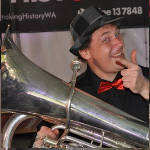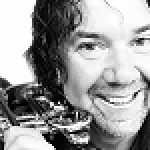Forum Replies Created
-
AuthorPosts
-
-
24 March 2018 at 3:54 am #3916
 discoduck100Participant
discoduck100ParticipantHi Everyone glad to be on board. I’ve bought a copy of Mystery to Mastery and have signed up to be apart of Wind Works testing. I’m not fully sure what access I am supposed to have. I have access to the MTM eBook #1 and this forum, but not any of the Wind Work lessons. This seems right to me I guess.
Is there any more information on the progress of Wind Works? ie Completion Date? Course Cost? Goals / Hurdles?
Let me know if there is any way I can help.
Cheers.
discoduck (AJ) -
5 April 2018 at 4:04 pm #4009
Anonymous
InactivePlease give us your thoughts of WindWorks course.
-
5 April 2018 at 5:10 pm #4025
 g2Participant
g2ParticipantTotally love it!
-
6 April 2018 at 7:45 pm #4027
gillardtrumpet
ParticipantI’m really excited by this course. I’ve been applying Greg’s principles to my own playing with great success. Has anyone else found SHAPE and APERTURE to be a revelation when approaching flexibility? In the past I spent a long time focused on BLOW which lead to force.
-
7 April 2018 at 2:48 am #4029
kenmamyb
ParticipantTaking the time to go through this course and apply it’s principals will be very beneficial for players of all levels. For me, the benefit is in woking with the concepts enough to internalize them, not in how quickly one can get through the material. I like to emphasize the feeling of the ‘Singing C’ as a base line for moving on to other pitches, hopefully without added tension.
Great stuff Greg!!
-
15 April 2018 at 2:10 pm #4065
Andrew Chambers
ParticipantG’day brass lovers, thought I’d share a positive experience and pose some questions. As a bass trombonist I thought I could no longer get a decent sound out of the tenor trombone. MTM has helped me to realise that if I don’t overblow this doen’t need to be the case and I am now getting back into the tenor trombone as a doubling instrument. Do any of you doublers have any advice? Should you aim for a mouthpiece and instrument as close as possible to your primary instrument (in my case large bore and large mouthpiece) or treat it as a completely different instrument and sound concept? Do you play your main instrument every day or alternate sometimes? Any other tips?
-
19 April 2018 at 1:39 pm #4208
 rod1Participant
rod1ParticipantWelcome to the forum Mr Chambers! Look forward to seeing what the answer is to this question!
-
3 May 2018 at 3:38 pm #4403
Nicky Kurta
ParticipantHey there,
Long time listener, first time caller 🙂When I use the practice charts, is it meant to record my progress. i.e. if I mark the chart and I log out, when I return should my markings still be there?
At the moment, I’m returning to empty charts.
Loving the course.
Cheers,
Nicky -
4 May 2018 at 12:50 am #4404
 matt.cor.ryanParticipant
matt.cor.ryanParticipantHi Nicky,
Yes, the records should remain even after you logout.
Thanks for pointing this out, it should now be fixed. Would you mind testing it again and letting me know if it’s working on your end?
Thanks!
Matt -
17 May 2018 at 6:41 pm #4459
Nicky Kurta
ParticipantLooks good, thank you 🙂
-
1 June 2018 at 12:48 am #4811
Guillaume M
ParticipantHi!
I purchased MTM book one a few weeks ago, but due to several reasons I still haven’t started yet.
So simple question : shall I start with MTM book 1 or with windworks ? or both ? 🙂Cheers,
Guillaume -
1 June 2018 at 12:52 am #4812
Guillaume M
ParticipantHi !
As there’s this forum now, let me tell you that I really love your videos, the way you explain things are very clear and it does make sense… Much more than with my last teacher.
So thank you Greg !
I haven’t started yet with WIndworks as I purchaded MTM book 1 two weeks ago, and I wanted to start it over again with those concepts… I am excited about it !
Cheers,
Guillaume -
1 June 2018 at 8:02 am #4849
malcolmfox641920
ParticipantHi. I am a little unsure about the ADAGIO STATUS COMPLETION as there are no instructions. Is it the same slur as in the LARGO STATUS COMPLETION C,G,C,G…?
-
2 June 2018 at 12:51 pm #4897
 g2Participant
g2ParticipantHi Malcolm, yes the process is the same. Do not be limited by the colors, use them as a guide and keep on getting quicker with the efficient process.
-
2 June 2018 at 12:55 pm #4898
 Greg SpenceKeymaster
Greg SpenceKeymasterHi Guillaume, great question. The answer is both 🙂 Really embrace the information from the videos of WindWorks over the text in book 1, it is clearer and more concise. Enjoy.
-
2 June 2018 at 12:59 pm #4899
 Greg SpenceKeymaster
Greg SpenceKeymasterMy pleasure Guillaume, very happy you are enjoying it. I have answered your other question on the other link. Best Wishes.
-
4 June 2018 at 8:28 pm #5201
 fmaziersParticipant
fmaziersParticipantHi Greg,
First of all thanks for this new site. It’s very well made. Bravo!
I have a question to ask you about setting embouchure because i think its as important as air managment. Indeed how to operate a whistle that is broken even if it blows well?
One can read, in the abundant literature for the trumpet, that several type of embouchures exist: Farkas (a pucker smile with firm corners and a flat chin in the book “The art of brass playing”), Maggio, superchops by Callet, Stevens embouchure; and that the Farkas one would be the most tiring for the same results than the others?! (lot of tension in the corner says Pops McLaughlin).
What do you think about that? What do you think about the book written by Farkas “the art of brass playing”? Have you some remarks to make about the fact that the best way to play is with Farkas embouchure? Is there another way to play thats takes less effort? What embouchure do you use? When i look at you its seems to me that yours lips are puckering a lot?
Kind regards.
-
4 June 2018 at 8:48 pm #5204
 fmaziersParticipant
fmaziersParticipantHi Greg,
Your new videos are very explicative (like before) but the quality is better and with a lot of humor.
Your theory is no the same as my teacher (he says “play on the air”. I don’t understand that. He says “makes more pression to go high” but he can’t says how? He says not to modifie the embouchure. The air is only the key! But for me unfortunately it doesn’t work!
So I’m going to work on your course seriously and i will see if it works.
Kind regards. -
5 June 2018 at 12:59 am #5237
 fmaziersParticipant
fmaziersParticipantHi Greg,
My professor explains that to play high, above E in the staff, we must think like singing a falsetto voice. What do you think about that? what’s going on when we do that? Its change the shape of the mouth? It’s change the pression in oral cavity?…
Kind regards. -
5 June 2018 at 8:41 am #5258
 Greg SpenceKeymaster
Greg SpenceKeymasterThanks for the question! As you will see as you work through the course, my approach is to find the optimum setting with the minimum amount of work. I believe the issues above are caused by far too much negative tension in the centre of the lip oscillator therefor increased air pressure is exerted thus making the cheek/facial muscles work way more than they need to.
Without having read Farkas in it’s entirety, I believe it was a study of the different set ups people used. All I can say is that a lot of my students have very different set ups based on their anatomy, but one thing is consistent – efficiency. I don’t let people get away with unnecessary internal tension.
The aaaahooooh is simply about discovering the aperture corners and getting the lips out of the way of the air column. Remember, the lips oscillates sympathetically on the air column.
I am certainly not a rolled in player as I ascend…I used to be when I was killing myself playing. I have learned to minimise the clamping and to engage from the aperture corners without choking off the air column as I ascend.
-
5 June 2018 at 8:46 am #5259
 Greg SpenceKeymaster
Greg SpenceKeymasterHi Francis, all I can say is work through and follow the course and it will make sense. Your teachers ideas are all too common and in his best endeavours to teach you is possibly just passing on what he/she was taught that worked for them.
Again, I have no problem with that approach if it works but you are the prime example of why I built this course – I am being told to do something but it is not working for me.
Enjoy the course.
-
5 June 2018 at 9:07 am #5262
 Greg SpenceKeymaster
Greg SpenceKeymasterThis will all be explained in a lot more detail a little further down in the advanced section of the course.
My reply to that ideology is:
1. Can you sing falsetto?
2. What do people that sing falsetto feel like when they sing? Is it a consistent feeling across the board? I suspect not.
3. What do people that sing falsetto think they are doing when singing high? Are they correct?
4. Does the idea work for you? If so, then go with it. It may cause confusion.Above a high C (more like concert d or Eb but for arguments sake lets say high c), the instrument basically becomes an amplifier of the mouthpiece buzz. DON’T SHOOT ME! This if from physicists and instrument makers – however, do I teach people to buzz high c’s on their mouthpiece? No! Why? Too much negative tension creeps in.
I think it might be more of a psychological approach rather than a direct technical analogy?!
It is a SHAPE change by virtue of the fact that the tension of the vocal cords is changing but that is getting in to a very complex comparison.
I certainly wouldn’t go in to the pressure in the oral cavity area either. Does it change? Possibly. Should we work on increasing pressure? NO WAY!
-
5 June 2018 at 10:06 am #5264
Hugh
ParticipantHey Greg,
First, I have to say that I’m really liking the course. It’s very well put together and has obviously been very well thought out. I’m a come back player, and I’m trying to get it right this time.I have been trying to study your lip setting on the videos. It doesn’t look like your lips are rolled in, and I have read and heard so many things – some have said “roll in when ascending and roll out when descending”. When rolled in, it seems like it’s necessary to kind of clamp down to keep the lips in that condition. I have not yet seen where you reference a “lip setting”, but I’ve not yet gone through everything! It is really confusing, so if you can address it, it would really be of help to me.
Thanks!
-
5 June 2018 at 10:26 am #5265
 Greg SpenceKeymaster
Greg SpenceKeymasterHey there Hugh, thanks for your really important question.
I am going to be totally honest with you, I cannot stand the psychology of “roll” in or out. That is not to say that the embouchure muscles surrounding the aperture do not engage or that the aperture size does not change. I must also add that if the idea works for someone, then they should totally embrace it; clearly it is not working for you.
I fear that the psychology of the “roll in” can create an incredible clamping down of the oscillator and encourage WAY too much activation of the musculature in the face and throughout the body. Now I am sure that not is the intended result of those that talk about rolling in, but I have seen time and time and time again the issues that this causes.
Consider that playing a wind instrument is the oscillation of an air column in the horn/body system and the lips responds to that system. If the oscillation goes from sympathetic to “synthetic” i.e. manipulated and artificial, this creates all kinds of inefficiencies.
I guess you could call the “aaaaahooooh” a roll out – similar to saying mmmmmmooooooo (like a cow)?!?!? maybe, depending on ones definition or idea behind it, but the whole idea of talking about aperture corners and the inward/horizontal sensation is to eliminate the clamping as you ascend. The concept of Roll In, in my mind, encourages clamping.
-
5 June 2018 at 11:52 am #5275
 a4audinutParticipant
a4audinutParticipantI am really starting to tune into using shape and lips to ascend and harmonic slur vs a kick and the sound is much more natural with much better initial intonation. I have noticed 2 things when I try to zen this feeling. “As I ascend to around G above the staff it seems like the movement to ascend is at the extreme of the front of the lips i.e. the very tip of the center. As I descend it seems the red farther back is the area responding. Is this a correct feel. I am having some issues landing a hi c as well and either end on an Aor the hi E, the c just seems to require more effort to land. Maybe I’m thinking and trying to internalize this too much for my own good. My core sound and initial response is much better so far, and I’m only on 1st level. Thanks for breaking all this down in a way I can understand
Rod -
5 June 2018 at 2:19 pm #5287
 Greg SpenceKeymaster
Greg SpenceKeymasterHi Rod, thanks for your email and pleased it is helping.
The sensation people have varies SO much that there is no right or wrong, it is so individual.
My sensation when playing in the upper register is like a tickle going across the middle of the lower lip. There is no feeling of back up or choking because it takes a lot less flow of air to play than what people think.
I can feel where my tongue is at, what my aperture corners are doing and how much air is required at different volumes. There are a lot more videos coming to explain this further.
All the best,
Greg -
5 June 2018 at 9:07 pm #5335
 fmaziersParticipant
fmaziersParticipantHi Greg,
First of all thanks very much for taking time to reply so quickly!
I hope i’am not boring you to much with my basics questions, but i am just an amateur (my job is family doctor) and my goal is not “to fight” with my trumpet. I just want to have fun and for me it’s rather a torture for 5 years that i take classes.I play know in 2 orchestras but i don’t feel good, i always feel on the tightrope and have sore lips at the end of the gig. I know the expression by Arnold Jacob “paralysis by analysis” however it’s seems to me that we must start (like any learning) on a good foundation. So here is my question.
When i see you with “whaou technic”, i have the impression that you play trumpet with your lips wide open. But my teacher says that the lips must be against each other like when we say dimmmm…. He says that the aperture is formed when the air is passing through the lips, and not made before, otherwise the sound is going to be airy, the endurance will suffer, and the high register will not be possible.
Thanks for your advice and conviction.
All the best! -
6 June 2018 at 1:06 am #5342
jackearnhartmusic
ParticipantWhen ascending, should one try to keep the lips even and on top of each other like saying TU and adjust the aperture corners from there, or does the lower lip roll in over the lower teeth creating an overlap?
-
6 June 2018 at 2:24 pm #5387
jackearnhartmusic
ParticipantHello again.
I find that with my abs totally relaxed, I can still close my throat. It seems the tongue isn’t what is holding the air back as a valve, it is the throat. Do you have any ideas on how to fix this?
-
6 June 2018 at 5:38 pm #5467
 Greg SpenceKeymaster
Greg SpenceKeymasterHi Jack, this is totally an awareness of the sensation so with eyes closed, take the Body’s Concert Hall breath, soft and slow EYE’S CLOSED and feel the freedom. Then make yourself choke and feel the difference. There is your point of difference. Using the Windbag from the WindPack is a great way of solving this issue. I will do a video on how to keep the throat open. Thanks
-
6 June 2018 at 5:41 pm #5470
 Greg SpenceKeymaster
Greg SpenceKeymasterHi again Francis, yes it can be a tough ride that is for sure.
Note that I said in the aaahoooh video that that is not the setting used all of the time, rather a way of discovering the aperture corners and feeling the free sensation that we want.
This will all be discussed in great detail in the Soft Long Tones video later in the course. Thanks, Greg
-
6 June 2018 at 5:44 pm #5471
 Greg SpenceKeymaster
Greg SpenceKeymasterIt is best to avoid rolling the lips over the teeth. Although there is no perfect way that is the same for everyone, ideally the lips stay aligned and forward and the Aperture Corners firm inwards horizontally and in the aaahoooh. Cheers
-
7 June 2018 at 1:21 am #5525
 wjtakacsParticipant
wjtakacsParticipantGreg! The course, videos, and website are fantastic! I am very excited to work through all of the levels! Ever notice how most if not all books with exercises to develop flexibility and range include a crescendo when ascending and/or an accent (^) on the top note? I’ve never understood that if all of these authors understood (and I’m assuming they did) that it actually takes less air to go higher. Hmmm…
-
7 June 2018 at 2:48 am #5536
 Ronald CarsonParticipant
Ronald CarsonParticipantI used my throat to stop the air and also used it to constrict the air in an effort to play in the upper register; which created a lot of tension and affected my voice afterward.
This bad habit still occurs, not so much in stopping the air, but a way of providing compression.
I would suggest you keep visualizing your body as a balloon. Hold your breath and only let your lips hold back the air. Your cheeks may puff out, let them. Do not let the throat engage at all. Release the air keeping the throat relaxed. Try this several time releasing the air in short bursts, stopping it only with the lips.
Now do the same thing using only the tongue to release and stop the air.
Sing a note and stop singing only by disengaging the vocal cords, air should come out of your mouth without the vocal cords vibrating. Do this several times and then do the same singing exercise but close the mouth immediately after disengaging the voice. You should feel air pressure buildup in your mouth. Sing again and this time stop the air with the tongue. If you relax the tongue, air goes out and the throat is relaxed the whole time.
Cheers
-
7 June 2018 at 9:00 am #5552
 Greg SpenceKeymaster
Greg SpenceKeymasterMorning Professor Takacs, Hmmmmm indeed, you wait till you hit the later Singing C Series exercises, they will spin you out (metaphorically not physically :-))
That approach by “most if not all books” is what has created the psychology that brass playing is hard work.
Thanks for the kind words. Premium Stage is almost done 🙂
-
-
AuthorPosts
Recent topics
-
Switching from L bore to ML bore
by
MikeB
5 days, 19 hours ago -
Tongue lock
by
Sylvain Arseneau
2 months ago -
Question of Curiosity – To Teeth or Not To Teeth
by
clawsonk123
4 months, 4 weeks ago -
1.O / 2.0 routine
by
jice.gif
6 months ago -
Abdominal surgery and time off the trumpet
by
DQ
1 year ago
